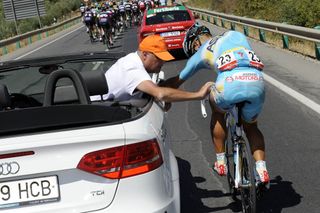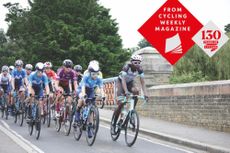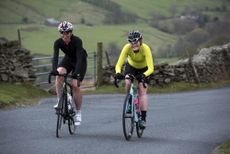Meet the race doctor who treated Lizzie Armitstead after her Women's Tour crash
Doctor Will Mangar talks to Maria David about providing medical support during the Women’s Tour

Dr Matt Gray and Dr Will Mangar, Women's Tour 2015

When Lizzie Armitstead crashed on the opening stage of the 2015 Women’s Tour, one of the first people at the scene was Dr Will Mangar. Along with fellow doctor Matt Gray, these are two of the most important people in the race convoy. They are the guys who patch the riders up after crashes and spills.
Dr Mangar, a GP from Kent, and owner of a sports medicine company, Indurance, has been the Women’s Tour doctor since the race began last year. As well as the Women’s Tour he works on the men’s Tour of Britain and for Ride London.
Mangar has had years of medical training but it didn’t include treating cyclists while moving.
“You might have a rider needing to come back to the car, so they hold onto the car and we treat them while they are going along,” Mangar explains.
“Most riders are very smart at knowing how to hold onto a car and ride at 50km/hour. You can’t train yourself to treat a rider while moving. You just pick it up as you go along. The car roof goes down and we swap from side to side to treat whichever rider we need to, whether the problem is on the left or the right.”
Such a key role means that the race doesn’t go if there isn’t a doctor’s car in the convoy behind the commissaire president. Comprising race doctor one, race doctor two, a paramedic motorcyclist and a rapid response vehicle Mangar’s team ensures that there is coverage at all times.
Mangar summarises, “If there’s a crash we make a quick assessment of the situation, and if I need to, I stay with that rider while doctor two stays with the race and I catch up later. Doctor two is our rapid response doctor, Dr Matt Gray, an anaesthetist. He steps in depending on the situation.”
Get The Leadout Newsletter
The latest race content, interviews, features, reviews and expert buying guides, direct to your inbox!
>>> Lizzie Armitstead suffers crash just seconds after winning Women’s Tour stage one (video)
So how did they deal with the Lizzie Armitstead crash? Dr Mangar replies generally to preserve rider-doctor confidentiality.
“As soon as you arrive at a crash you make sure the rider has got good airways and they are breathing, they’ve got circulation, and they can talk. You also look at the mechanism of the injury, check for any head injury and make sure there is no neck problem.
"Then you do a general assessment of all lumps, bumps, arms and legs. The team works seamlessly and quickly and we try and get the rider back on their bike if possible. In Lizzie’s situation that wasn’t appropriate.”
Dr Mangar is all too aware of the need to respond rapidly in a live environment. “Cycle racing is one of the few sports where the public comes so close to the riders,” he says. “Anything can happen, and the Lizzie Armitstead crash was a freak occurrence. We always have to be prepared for the unexpected.”

For stage races the doctor is constantly on call. “We go around to the hotels and see the riders in the evening, and we may get called for anything – coughs, colds, sniffles, hayfever, saddle sores. Your work is never done!”
Indeed, it was reported in the press that Joanna Rowsell suffered a reaction following a wasp sting, Katie Curtis had a Crohn’s disease flare-up, and Coryn Rivera discovered she had a broken wrist having ridden stage two after coming down in the Armitstead crash.
Dr Mangar notes a palpable shift in the quality and skill level of the racing this year compared with last year and overall there have been fewer injuries, though he is very impressed at the riders’ resilience.
“We had a bad crash yesterday in the neutral zone. One of the Rabobank riders went down very heavily and was winded, but she got back on the bike. I am amazed at how tough these girls are. It takes a lot for them to not want to get back on their bike.”
Video: Women's Tour stage one highlights

Thank you for reading 20 articles this month* Join now for unlimited access
Enjoy your first month for just £1 / $1 / €1
*Read 5 free articles per month without a subscription

Join now for unlimited access
Try first month for just £1 / $1 / €1

Nigel Wynn worked as associate editor on CyclingWeekly.com, he worked almost single-handedly on the Cycling Weekly website in its early days. His passion for cycling, his writing and his creativity, as well as his hard work and dedication, were the original driving force behind the website’s success. Without him, CyclingWeekly.com would certainly not exist on the size and scale that it enjoys today. Nigel sadly passed away, following a brave battle with a cancer-related illness, in 2018. He was a highly valued colleague, and more importantly, an exceptional person to work with - his presence is sorely missed.
-
 Hire and hire: Bike rental schemes hit record numbers in the UK, almost topping 25 million rides
Hire and hire: Bike rental schemes hit record numbers in the UK, almost topping 25 million ridesAn average of 67,565 rides were taken a day between September 2022 and September 2023, an increase of 24%
By Adam Becket Published
-
 Egan Bernal says he has regained his pre-crash form, but others have improved
Egan Bernal says he has regained his pre-crash form, but others have improvedColombian, who suffered traumatic training accident in 2022, aiming for return to Tour de France
By James Shrubsall Published
-
 Tweets of the week: A wholesome Women's Tour edition full of schoolchildren, dancing, and Shrek
Tweets of the week: A wholesome Women's Tour edition full of schoolchildren, dancing, and ShrekThe Women's WorldTour comes to England and Wales, and encounters some good things
By Adam Becket Published
-
 Grace Brown takes the stage win after a stunning stage four at the Women’s Tour
Grace Brown takes the stage win after a stunning stage four at the Women’s TourThe Australian proved too powerful in the closing stages as she sprinted to victory in Welshpool
By Owen Rogers Published
-
 Lorena Wiebes secures another convincing Women's Tour victory with stage three win
Lorena Wiebes secures another convincing Women's Tour victory with stage three winThe Team DSM rider powered away from the rest of the field to take her second consecutive stage victory
By Owen Rogers Last updated
-
 Women's Tour organiser seeking title partner to deliver live coverage of event
Women's Tour organiser seeking title partner to deliver live coverage of eventSweetSpot is hoping to raise £75,000 from a sponsor so it can broadcast the race live and adhere to UCI rules
By Ryan Dabbs Published
-
 Life through a lens on the Women's Tour
Life through a lens on the Women's TourWriter James Shrubsall swapped his pen and paper for a camera and joined Simon Wilkinson at the Women's Tour last year
By James Shrubsall Published
-
 Tour of Britain and Women's Tour generated £34 million in 2021, research reveals
Tour of Britain and Women's Tour generated £34 million in 2021, research reveals1.3 million spectators also watched 14 days of racing across the two events
By Ryan Dabbs Published
-
 The Women's Tour will not be broadcast live on TV in 2021
The Women's Tour will not be broadcast live on TV in 2021Despite having an agreement with Eurosport GCN the women's Tour of Britain is not able to broadcast live
By Tim Bonville-Ginn Published
-
 Strava survey shows majority of female riders feel there are no barriers to cycling
Strava survey shows majority of female riders feel there are no barriers to cyclingSixty per cent of women surveyed by Strava believe there are no barriers to entry for women who want to cycle
By Stuart Clarke Published